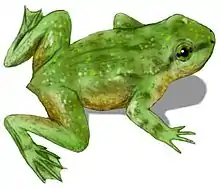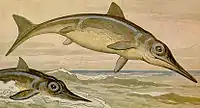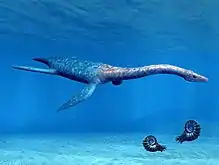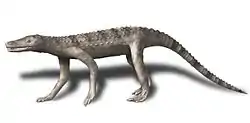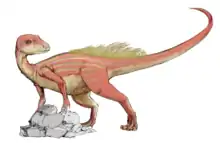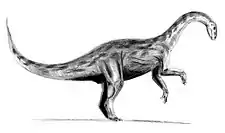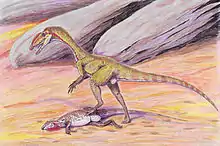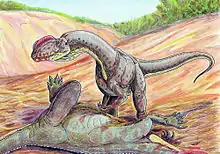Sinemurian
In the geologic timescale, the Sinemurian is an age and stage in the Early or Lower Jurassic epoch or series. It spans the time between 199.3 ± 2 Ma and 190.8 ± 1.5 Ma (million years ago).[3] The Sinemurian is preceded by the Hettangian and is followed by the Pliensbachian.[4]
| Sinemurian | |
|---|---|
| 199.3 ± 0.3 – 190.8 ± 1.0 Ma | |
 Jurassic rock strata in the cliffs at East Quantoxhead, near the Sinemurian golden spike. | |
| Chronology | |
Key events in the Jurassic -200 — – -195 — – -190 — – -185 — – -180 — – -175 — – -170 — – -165 — – -160 — – -155 — – -150 — – -145 — – how to approximate the timescale of key Jurassic events. Vertical axis: millions of years ago. | |
| Etymology | |
| Name formality | Formal |
| Usage information | |
| Celestial body | Earth |
| Regional usage | Global (ICS) |
| Time scale(s) used | ICS Time Scale |
| Definition | |
| Chronological unit | Age |
| Stratigraphic unit | Stage |
| Time span formality | Formal |
| Lower boundary definition | FAD of the Ammonites Vermiceras quantoxense and Vermiceras palmeri |
| Lower boundary GSSP | East Quantoxhead, West Somerset, England, UK 51.1909°N 3.2364°W |
| GSSP ratified | 2000[1] |
| Upper boundary definition | FAD of the Ammonite species Bifericeras donovani and genus Apoderoceras |
| Upper boundary GSSP | Robin Hood's Bay, Yorkshire, England, UK 54.4069°N 0.4975°W |
| GSSP ratified | March 2005[2] |
In Europe the Sinemurian age, together with the Hettangian age, saw the deposition of the lower Lias, in Great Britain known as the Blue Lias.
Stratigraphic definitions
The Sinemurian stage was defined and introduced into scientific literature by French palaeontologist Alcide d'Orbigny in 1842. It takes its name from the French town of Semur-en-Auxois, near Dijon. The calcareous soil formed from the Jurassic limestone of the region is in part responsible for the character of the classic Sancerre wines.
The base of the Sinemurian stage is at the first appearance of the ammonite genera Vermiceras and Metophioceras in the stratigraphic record. A global reference profile (GSSP or golden spike) for the Sinemurian stage is located in a cliff north of the hamlet of East Quantoxhead, 6 kilometres east of Watchet, Somerset, England.[5]
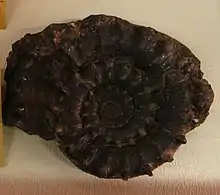
The top of the Sinemurian (the base of the Pliensbachian) is at the first appearances of the ammonite species Bifericeras donovani and ammonite genus Apoderoceras.
The Sinemurian contains six ammonite biozones in the Tethys domain:
- zone of Echioceras raricostatum
- zone of Oxynoticeras oxynotum
- zone of Asteroceras obtusum
- zone of Caenisites turneri
- zone of Arnioceras semicostatum
- zone of Arietites bucklandi
Palaeontology
Amphibians
| Amphibians of the Pliensbachian | ||||
|---|---|---|---|---|
| Taxa | Presence | Location | Description | Images |
| Kayenta Formation, Arizona | Currently the oldest known anuran, which lived well before the first known modern frog, Callobatrachus of the Early Cretaceous . | |||
Synapsids
| Non-Mammaliaform Synapsids of the Sinemurian | ||||
|---|---|---|---|---|
| Taxa | Presence | Location | Description | Images |
| A tritylodontid cynodont. | ||||
Mammaliaformes
| Mammaliaformes of the Sinemurian | ||||
|---|---|---|---|---|
| Taxa | Presence | Location | Description | Images |
| Yunnan, China | The earliest known example of several features distinctive to mammals, including mammal-like mandible and middle-ear structures and a relatively large brain cavity. | |||
| From Norian to Sinemurian | Greenland and Western Europe | A Late Triassic-Early Jurassic symmetrodontan. | ||
†Ichthyosaurs
| Ichthyosauria of the Sinemurian | ||||
|---|---|---|---|---|
| Taxa | Presence | Location | Description | Images |
| From Hettangian to Sinemurian | Belgium, England, Germany | Among the best known ichthyosaur genera, was smaller than most of its relatives, measuring 2 m (6 ft 7 in) in length. | ||
| Europe | ||||
| Hettangian to Toarcian | All over Europe | An ichthyosaur that exceeded 12 metres (39 ft) in length | ||
†Plesiosaurs
| Plesiosauria of the Sinemurian | ||||
|---|---|---|---|---|
| Taxa | Presence | Location | Description | Images |
| Blue Lias Formation, England | A rhomaleosaurid pliosaur. | |||
| Blue Lias Formation, England | A basal pliosaurid around 5 meters long. | |||
| Granby, Leicestershire, England | May have been a rhomaleosaurid, pliosaurid, microcleidid or elasmosaurid | |||
|
Sinemurian and Toarcian | Lyme Regis, Dorset, England | A large (about 3 to 5 meters long), marine sauropterygian reptile, it was distinguished by its small head, long and slender neck, broad turtle like body, a short tail, and two pairs of large, elongated paddles | |
Crocodylomorpha
| Crocodylomorphs of the Sinemurian | ||||
|---|---|---|---|---|
| Taxa | Presence | Location | Description | Images |
| Dark Red Beds, Lufeng Formation, Yunnan, China | Dibothrosuchus was a sphenosuchian, a basal crocodylomorph. | |||
| Kayenta Formation, Arizona | Despite the similar cranial morphology with crocodilians, the genus is currently regarded as a basal crocodyliform although more derived than protosuchians. | |||
| South Africa | A small, gracile non-crocodyliform sphenosuchian crocodylomorph. | |||
| Red Beds Formation, Qacha's Nek Province, Lesotho | A genus of small protosuchian crocodyliforms. | |||
| Dark Red Beds, Lufeng Formation, Yunnan, China | A sphenosuchian crocodylomorph. Because some of its teeth were leaf-shaped it does not appear to have been a strict carnivore like most other crocodylomorphs. | |||
†Ornithischians
| Ornithischians of the Sinemurian | ||||
|---|---|---|---|---|
| Taxa | Presence | Location | Description | Images |
| From Hettangian to Sinemurian | Upper Elliot Formation, Lesotho and Cape Province, South Africa | Considered the most basal member of the family Heterodontosauridae | ||
| Lower Lufeng Formation, Yunnan, China | A dubious genus of thyreophoran dinosaur. Possibly identical to Tatisaurus. | |||
| From Hettangian to Sinemurian | Lesotho | As the only fossil known of it is a partial jawbone with three teeth, Fabrosaurus is a nomen dubium and may in fact be the same as Lesothosaurus. | ||
| Clarence Formation, Cape Province, South Africa | With few remains, it is considered a nomen dubium. It is classified as an ornithischian based on the jaw. | |||
|
From Hettangian to Sinemurian | Upper Elliot Formation, Orange Free State, South Africa | A heterodontosaurid ornithischian | |
| Date disputed | Unknown location in Portugal | Only known from a partial snout with teeth. Lusitanosaurus is a genus of large basal thyreophoran dinosaur, probably closely related to Scelidosaurus. | ||
| From Hettangian to Sinemurian | Upper Elliot Formation, Cape Province, South Africa | A small herbivore dinosaur despite long canines it sported in its jaws; due to this unique characteristic it is very clearly allied to Heterodontosaurus | ||
|
England | Disputed, considered by some to be a tetanuran theropod | ||
| From Hettangian to Sinemurian | Charmouth, West Dorset, England; Kayenta Formation, Arizona, USA | A genus of quadrupedal, lightly plated, herbivorous dinosaur about 4 meters (13 feet) long. A basal member of Thyreophora. | ||
| Sinemurian | Kayenta Formation, Arizona, USA | One of the earliest representatives of the armored dinosaurs and the basalmost form discovered to date. It was a small, lightly-built, ground-dwelling, herbivore, that could grow up to an estimated 1.2 m (3.9 ft) long. | ||
| From Hettangian to Sinemurian | Stormberg Series Formations, South Africa, Lesotho | A primitive ornithischian, about 2 meters (6 feet 7 inches) long. The proportions of the posterior limbs show differences with those of Lesothosaurus, and reveal a lower ability to run | ||
| Lufeng Formation, Yunnan, China | Tatisaurus is a genus of basal ornithischian dinosaur from China. Little is known as the remains are fragmentary but it's likely a thyreophoran related to Scutellosaurus and Scelidosaurus. | |||
†Sauropodomorpha
| Sauropodomorphs of the Hettangian | ||||
|---|---|---|---|---|
| Taxa | Presence | Location | Description | Images |
| Sinemurian to Pliensbachian | Zimbabwe | A small very basal sauropod. | ||
| Early-Middle Jurassic | Yunnan Province, in China | A large basal sauropodiform. | ||
Theropoda
| Theropods of the Sinemurian | ||||
|---|---|---|---|---|
| Taxa | Presence | Location | Description | Images |
| Sinemurian | Kayenta Formation, Arizona, USA | A medium-small sized theropod, C. kayentakatae had two small, parallel crests which may demonstrate an evolutionary step toward later and larger neotheropods, such as the more advanced and larger Dilophosaurus and Sinosaurus. | ||
| Sinemurian to Pliensbachian | Arizona, USA | Measured around six meters (20 ft) long and may have weighed half a ton. The most distinctive characteristic of Dilophosaurus is the pair of rounded crests on its skull, possibly used for display. | ||
| Sinemurian | Leicestershire, England | Measured around 3.5 meters (11 feet) long. The most distinctive characteristic of Sarcosaurus is its pelvis which is remarkably similar to Dilophosaurus'. | ||
| Early Sinemurian | Saltrio, Northern Italy | Measured 7,5 meters and weighed one ton. It was a basal ceratosaur. | ||
| Sinemurian | Zhangjiawa Member, Lufeng Formation, Yunnan, China | Sinosaurus was a one of the oldest and most basal tetanuran theropods. It measured approximately 5.6 meters in length. | ||
References
- Bloos, Gert; Page, Kevin (March 2002). "Global Stratotype Section and Point for base of the Sinemurian Stage (Lower Jurassic)". Episodes. 25 (1): 22–28. doi:10.18814/epiiugs/2002/v25i1/003. Retrieved 23 December 2020.
- Meister, Christian; Aberhan, Martin; Blau, Joachim; Dommergues, Jean-Louis; Feist-Burkhardt, Susanne; Hailwood, Ernie; Hart, Malcolm; Hesselbo, Stephen; Hounslow, Mark; Hylton, Mark; Martin, Nicol; Page, Kevin; Price, Greg (June 2006). "The Global Boundary Stratotype Section and Point (GSSP) for the base of the Pliensbachian Stage (Lower Jurassic), Wine Haven, Yorkshire, UK". Episodes. 29 (2): 93–106. doi:10.18814/epiiugs/2006/v29i2/003. Retrieved 23 December 2020.
- Benton, Michael J. (2012). Prehistoric Life. Edinburgh, Scotland: Dorling Kindersley. pp. 44–45. ISBN 978-0-7566-9910-9.
- For a detailed geologic timescale see Gradstein et al. (2004)
- See for the description of the GSSP Bloos & Page (2001)
Sources
- Bloos, G. & Page, K.N.; 2001: Global Stratotype Section and Point for base of the Sinemurian Stage (Lower Jurassic), Episodes 25(1), pp. 22–28, PDF
- Gradstein, F.M.; Ogg, J.G. & Smith, A.G.; 2004: A Geologic Time Scale 2004, Cambridge University Press.
- d´Orbigny, A.C.V.M.D.; 1842: Paléontologie française. 1. Terrains oolitiques ou jurassiques, Bertrand, Paris. (in French)
See also
External links
- GeoWhen Database - Sinemurian
- Lower Jurassic timescale, at the website of the subcommission for stratigraphic information of the ICS
- Stratigraphic chart of the Lower Jurassic, at the website of Norges Network of offshore records of geology and stratigraphy
